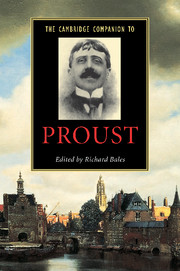Book contents
- Frontmatter
- Introduction
- 1 From Belle Epoque to First World War
- 2 The vast structure of recollection
- 3 Ruskin and the cathedral of lost souls
- 4 The birth and development of A la recherche du temps perdu
- 5 Lost and found: the structure of Proust’s novel
- 6 Proust’s Narrator
- 7 The unconscious
- 8 The texture of Proust’s novel
- 9 Proust’s human comedy
- 10 Proust and social spaces
- 11 Love, sexuality and friendship
- 12 Proust and the fine arts
- 13 Proust and posterity
- Postlude
- Select bibliography
- Index
3 - Ruskin and the cathedral of lost souls
Published online by Cambridge University Press: 28 May 2006
- Frontmatter
- Introduction
- 1 From Belle Epoque to First World War
- 2 The vast structure of recollection
- 3 Ruskin and the cathedral of lost souls
- 4 The birth and development of A la recherche du temps perdu
- 5 Lost and found: the structure of Proust’s novel
- 6 Proust’s Narrator
- 7 The unconscious
- 8 The texture of Proust’s novel
- 9 Proust’s human comedy
- 10 Proust and social spaces
- 11 Love, sexuality and friendship
- 12 Proust and the fine arts
- 13 Proust and posterity
- Postlude
- Select bibliography
- Index
Summary
When Proust announced to Marie Nordlinger in December of 1899 that he had begun working on something different from what he usually did, dealing with Ruskin and certain cathedrals, he could scarcely have imagined upon what a long road he was embarking, or where it would lead him. Perhaps without realising it, he had closed the early period of his literary apprenticeship and begun a new era in which he would exercise his talents as a critic and translator, rather than as a creative writer. Before this second period was completed, Proust would publish two translations of Ruskin's works, and various articles and reviews about him. Though it might seem that this labour of erudition was a detour from his main path as a writer, and though he often chafed under the constraints it imposed on his creative imagination, it was in fact his Ruskin work that paradoxically led him to the discovery of a form for the narrative he was later to write, A la recherche du temps perdu.
Proust had made his literary début in 1893 with the publication of Les Plaisirs et les jours, a collection of texts that were largely traditional in form, cast in the classical and symbolist moulds he had inherited from his immediate literary predecessors. When he later embarked upon writing a novel, he again tried to shape it within the framework of conventional nineteenth-century forms, the autobiographical novel and the Bildungsroman, or novel of growth and self-discovery. It seems likely that the reason he never finished this narrative (published posthumously under the title Jean Santeuil) was his dissatisfaction with its structure.
- Type
- Chapter
- Information
- The Cambridge Companion to Proust , pp. 42 - 57Publisher: Cambridge University PressPrint publication year: 2001
- 1
- Cited by



